HOUSEBOAT WITH A VIEW
INDIA: Finding tranquility on the backwaters of Kerala
The Province 13 Oct 2009 BY JACK DRURY
ALAPPUZHA, India — A woman in a lime coloured sari paddles a canoe past us. Her clothing blends, chameleon-like, into the emerald landscape.
A blue and orange kingfisher sits high on a branch over the river, ready to dive into the water for its next meal.
By the water’s edge, children play as women wash laundry, pounding bundles of soapy wet clothes on flat rocks. Other women sit chin deep, fully clothed in the dark, warm water. Washing themselves, they stop, and like crocodiles with only their heads exposed, follow the movement of our boat as it drifts along. All the while, men sit Plato-like on the shores.
Ellen and I made the 16-hour, 800 kilometre train journey here from the former Portuguese colony of Goa, seeking tranquility. But, if only for a day, we want our own floating palace; to live like a queen and her king on the paradisiacal backwaters of Kerala.
Backwater houseboats were originally barges used to transport harvested rice along the inland waterways. Today, many of the barges have been converted into elaborate thatched-roofed floating cottages — or palaces, depending on your outlook.
Our crew consists of Thom the Captain, Mathew, his Gilligan-like first mate, and Mani, our cook.
The hull of our 20-metre vessel is constructed of Jackwood.
The walls and roof are made entirely from tied together coir rope, constructed from the fibres found between the husk and outer shell of the coconut. Our palatial ark, as I’ve come to call it, has an open-air lounge and dining room at the bow. Behind the dining room is the bedroom with ensuite shower and all-important western toilet. The galley, or kitchen, is at the back.
The briny chain of waterways that we drift through lies inland, alongside the Arabian Sea. It’s a place where salt water and fresh water meet, where fish of different species and environments have learned to adapt.
As we move gently down the canals, into the lagoons and up the rivers, we continue to see odd yet familiar flags along the shore.
Kerala is ruled by a freely elected Communist government. It’s been this way, on and off, for more than 50 years. Who’d have thought that in a corner of India, the world’s largest democracy, there’d be a place for Lenin or Mao? Or that red hammer and sickle flags would fly from boat moorings, hydro wires and telephone poles? It has a nouveau Communism feel to it, though, with Lenin and Mao taking the back seat to the more marketable, but nonetheless still departed, Che Guevara, whose posters adorn streets and waterways everywhere.
It’s noon and Mani has just served us grilled fish, caught off the side of our boat.
“The fish is half saltwater, half freshwater. Some people don’t like too much salt,” he guffaws.
I taste the fish and ask, “Is there any hot chili sauce flowing in these waters, Mani?”
Smiling, he returns with a couple of fresh chili peppers, and a sharp knife. Midway through lunch, drenched in a chili sweat, I notice Ellen glaring. She’s fixed her stare on a television, DVD and stereo sitting on a stand in the corner. Then she turns to me with a “you take care of this” look.
“Does the TV and stereo work?” I casually ask Captain Thom as he serves us a plate of chapati bread.
“I have all the best music — disco from America. You like Madonna?”
“Madonna?” Ellen shrieks, as I place a calming hand on her arm.
I take a bite of chapati, fake a smile, need a plan.
No music will be listened to; no television watched tonight, Captain. This is my bloody boat, at least for 22 hours.
I want to say these words, but my demands are silent, caught on the back of my tongue.
I decide to handle the situation in a clandestine manner — a non-confrontational coward’s approach. While the crew is off doing the dishes, or perhaps polishing their dancing shoes, I inspect the stereo and then surreptitiously pluck a wire from its connection; not destruction, just simple time-consuming sabotage. To buy us enough time for a peaceful, Madonna-free evening.
At 6:45 a.m., the twilight of dawn peeks through our bedroom window. I scramble out of bed and rush to the bow, tripping over Mathew, who’s sleeping on the deck. He mumbles only a little as I pick myself up and bounce towards the edge of the boat.
We’re in semi-darkness still, but the canal is a hub of activity. Colourfully clothed men and women sit atop saucer-like boats, some with hook and line, others with net, trying for an early morning catch. A church bell rings as a striped fish jumps, then dives deep after clamping its mouth around a hovering bug.
Up the canal I hear the Muslim call to prayer. Religion is OK in this Che-inspired socialist state.
Just off the bow a saucer-boat fisherman hauls in his net.
A dozen or so silvery, herring-sized fish flop frantically.
Across an adjoining river I see a cross atop a Catholic church, and people, lots of people, walking towards the entranceway.
The night before, as Ellen and I sat on deck, quietly listening for night birds, Hindu chanting echoed off the waters.
The melodic sounds came from across the lagoon and later lulled us to sleep.
What more could we want or need. Exotic, tasty fauna and flora, curious humans, and Gods from all the heavens.
.
India — the Outs and Ins
.
The 'mass of humanity' and the 'stink' were just a few of the scary words I'd heard about India, before leaving Toronto. When we arrived at Indira Gandhi International Airport in Delhi back in mid-January it felt more like Toronto Island Airport than Pearson International. All of the people seemed to have gone somewhere else and taken their smells with them. The drive from Delhi Airport to New Delhi was far less busy than a run from Pearson to Yonge and Bloor in Toronto's downtown core at midnight would be. The reason of course is that here in western society most of us require our own personal people moving devices.
In India - and lucky for them - that is simply not possible. What they have as an alternative are planes, trains and buses. And the beauty of this as a western traveler is that your options become both simple and wide ranging. India has an extensive rail system. You can choose to be alone simply by paying a little extra for sleeper compartment seating with A/C. The cost isn't much for the westerner, but prohibitive for a good many Indians. And if you want a bit adventure you can simply buy an inexpensive first-come-first-served, find your own seat in the 'mass of humanity' train car.
Once we got on an early morning cheapo train where there was a fellow sleeping lengthways along an entire bench seat. I simply sat on his feet. When he let out a bit of a yelp, I smiled and said "I sorry. I didn't see you there." He quickly sat up.
Where trains don't go, buses do. They're crowded, inexpensive and great for getting stared at. I came to like the stares - no one pays any attention to me in Toronto. Once, at a nature reserve, we came upon a group of well off locals who'd just seen a pair of tigers at close range.
When they saw us, the tigers were all but forgotten. Out came the SLR digitals and snappity, snap, snap. Ellen and I became the focus of attention.
We took a couple of domestic flights. One from Udaipur in Rajasthan to Bombay and another from Bombay to Goa. The flights were each about an hour long and we were fed tasty meals and given warm blankets on both. Try asking Air Canada when dinner will be ready on your next five hour flight across the continent. And you better have a toonie in your pocket if you catch a chill. Air Canada rents their blankets now.
Another travel option in India is to hire a car and driver. This is an expensive way of getting from A to B, but worth considering. We hired a car to take us (11 hours) from Jaisalmer to Udaipur. The roads, some of them four-lane, were so clear that camels, goats, cows and dogs made better use of them than the 'mass of humanity'. Once as we sped along the highway we came across a small puppy sleeping right in the middle of the road. Neither the driver nor the pup was concerned as we simply swerved around the sleeping canine.
As the weeks went on we became more and more able to deal with the hassling shopkeepers. One time we walked by a clothing store where the comical clerk, realizing we weren't going to pay him a visit shouted, "Come into my store and let me rip you off."
Another time, out of the corner of my eye I saw a fellow coming up behind me with bundles of shirts, scarves and jewellery. I unbuckled my wristwatch. Before the street seller had a chance to utter a word I turned on him and said, "You want buy watch? I make you very good price, only 40,000 rupees." His jaw dropped as he looked at me strangely. "How much you pay? You my first customer today. First customer always bring good luck, for you, only 30,000 rupees. Come, look at my watch. It beautiful Seiko, my friend make in his shop." By now I was speaking loudly as the shirt and jewellery man was almost out of ear-shot.
.
India is a decent travel destination. For the most part the people are wonderful. The food is fabulous. And they have an infrastructure that works. I'd expected mostly 20- something backpackers.
They were there, but the bulk is older folks, often hobbling on weakened knees and hips. It's definitely a vacation spot, not the adventure destination I'd been expecting.
Oh, and the 'stink' I mentioned earlier. The water-filtration plant at Ashbridges Bay a few kilometres east of our home in Toronto can be worse than anything I smelled in India.

 Alleppey, Kerala, India
Alleppey, Kerala, India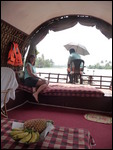
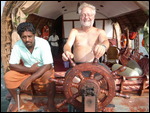
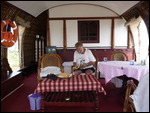
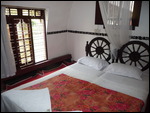
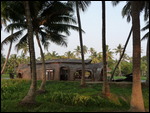
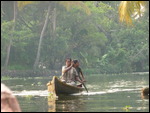
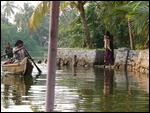
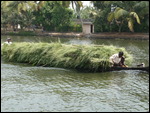
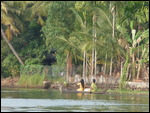












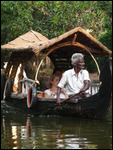
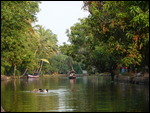
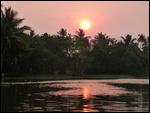
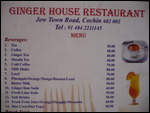
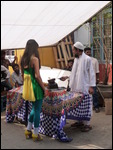
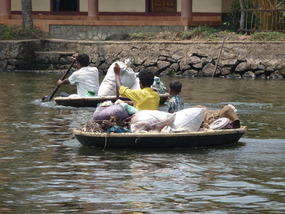
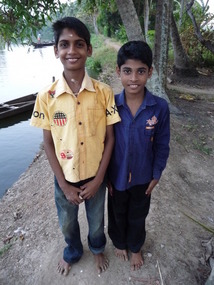


2025-05-22